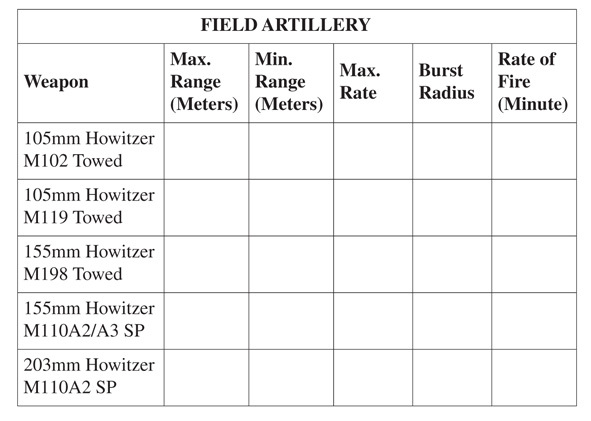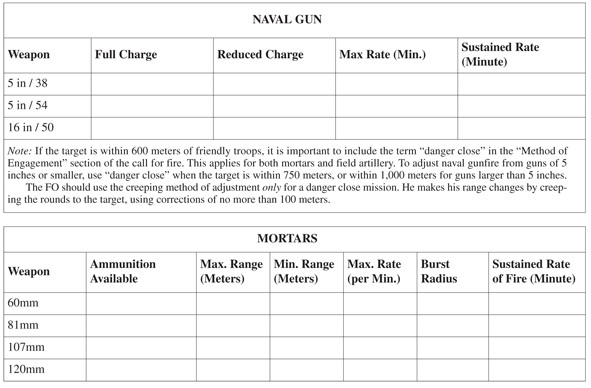•The infantry should not ride with anything more than their battle gear. Personal gear should be transported elsewhere.
PART TWO
Soldier Combat Skills
10
Call for and Adjust Fire
A call for fire is a concise message prepared by an observer (a person needing indirect-fire support). A soldier or a forward observer (FO) can prepare and request a call for fire but must plan targets and follow proper call-for-fire procedures (see coordination checklists, pages 24 and 28–29) in order to receive immediate fire support. Send a call for fire quickly but clearly enough that it can be understood, recorded, and read back to the observer without error.
PRINCIPLES: FORWARD OBSERVER EXERCISE
FOs must continually select or prearrange targets in support of the commander’s intent.
•Consider what the commander wants to do.
•Plan early and continuously.
•Exploit all available targeting assets.
•Use all available lethal and non-lethal fire support means.
•Use the lowest echelon able to furnish effective support.
•Observe all fires.
•Use the most effective fire support available.
•Provide adequate fire support.
•Avoid unnecessary duplication.
•Provide for safety, friendly forces, and installations.
•Provide for flexibility.
•Furnish the type of fire support requested.
•Consider the airspace.
•Provide rapid and effective coordination.
•Keep all fire support informed.
FIRE SUPPORT TASKS FOR ALL OPERATIONS
The unit providing fire support should be able to accomplish the following tasks:
•Locate targets.
•Integrate all available assets.
•Destroy, neutralize, or suppress all enemy fire systems (direct or indirect).
•Provide illumination and smoke.
•Prepare for future operations.
•Provide positive clearance of fires.
OFFENSIVE OPERATIONS
Offensive operations are additional tasks the fire support units must complete during offense.
•Support the movement to contact or chance contact.
•Soften enemy defenses with short, violent preparations.
•Provide support during attack by attacking high-payoff targets.
•Plan for deep and flanking fires.
•Plan for fires during consolidation.
•Provide counter fires.


TARGET OVERLAY
A complete fire support overlay must include the following:
Unit and official capacity of person making overlay
Date the overlay was prepared
Map sheet/number
Effective period of overlay (from when to when)
Priority targets
ORP grid/location
Call signs and frequencies (primary and alternate)
Routes (primary and alternate)
Phase lines and checkpoints used by the patrol
Index marks to position the overlay on the map (grid reference marks)
Objective
Target symbols (description and grid)
A sterile overlay is a security measure in case of enemy capture and must include target symbols and index marks to position the overlay on the map.
TARGET OVERLAY SYMBOLS
Target Type
Symbol
Notes
Point target
Less than 200 meters in length and width
Linear target
More than 200 meters but less than 600 meters long
Circular target
Undisclosed area and desired radius
DANGER CLOSE
Danger close refers to the minimum safe distance from the blast radius:
Mortars = 600 meters
Artillery = 600 meters
Naval guns:
5 inches or smaller = 750 meters
Over 5 inches = 1,000 meters
16 inches = 2,000 meters
AIRCRAFT CHART—MINIMUM SAFE DISTANCE TO EXPLODING ORDNANCE (BOMBS)
Weapon/Munition
Protected Troops
Unprotected Troops
Bomb—1,000 lb.
240 meters
1,000 meters
Bomb—750 lb. low drag
195 meters
750 meters
Bomb—750 lb. high drag
150 meters
750 meters
Bomb—500 lb. low drag
220 meters
500 meters
Bomb—500 lb. high drag
145 meters
500 meters
Bomb—500 lb.
145 meters
500 meters
CBU (clamshell only)
1,000 meters
1,000 meters
Rockets
220 meters
220 meters
Napalm
115 meters
115 meters
ELEMENTS AND SEQUENCE OF CALL FOR FIRE
Observer’s Identification/Call Sign
Warning Order
Adjust fire
Fire for effect
Suppress
Immediate fire suppression
Size of element to fire for effect (when the observer does not specify what size, the battalion fire direction center will decide)
Method of Target Location
Polar plot
Shift from a known point (give TRP)
Grid
Location of Target
Grid coordinate: six-digit for large area, eight-digit for smaller, ten-digit for point
Shift from a known point:
Send observer target (OT) direction:
Mils (nearest 10); Degrees; Cardinal direction; Send lateral shift (right/left, nearest 10 meters); Send range shift (add/drop, nearest 100 meters); Send vertical shift (up/down)—use only if over 35 meters (nearest 5)
Polar Plot:
Send direction (nearest 10 mils); Send distance (nearest 100 meters); Send vertical shift (nearest 5 meters)
Description of The Target
Type
Activity
Number
Degree of protection
Size and shape (length, width, or radius)
Method of Engagement
Type of adjustment (when the observer does not request a specific type, area fire is issued):
Area fire (moving target); Precision fire (point target)
Danger Close
When friendly troops are within:
600 meters for mortars; 600 meters for artillery; 750 meters for naval guns; 1,000 meters for naval guns greater than 5 inches; 2,000 meters for 16-inch naval guns (ICM or controlled variable time)
Mark
Used to orient observer or to indicate targets
Trajectory
Low-angle (standard)
High-angle (mortars or if requested)
Ammunition
HE quick will be used unless specified by the observer:
Projectile (HE, illum, ICM, smoke, etc.); Fuse (quick, time, etc.); Volume of fire (observer can request specific number of rounds)
Distribution
100-meter sheaf (standard)
Converged sheaf (small, hard targets)
Special sheaf (any length, width, or altitude)
Open sheaf (separate bursts)
Parallel sheaf (linear targets)
Method of Fire Control
Method of fire—specific guns and a specific interval between rounds. Normal adjust fire is one gun used with a five-second interval between rounds
Method of control:
“At my command, fire” remains in effect until observer announces, “Cancel at my command”
“Cannot observe”—observer can’t see the target
“Time on target”—observer tells FDC when rounds should impact
“Continuous illumination”—calculated by FDC unless observer indicates interval between rounds in seconds
“Coordinated illumination”—observer may order the interval between illum and HE shells
“Cease loading”—indicates suspension of loading rounds
“Check firing”—immediate halt in firing
“Continuous fire”—load and fire as fast as possible
“Repeat”—fire another round with or without adjustments
Authentication
Challenge and reply